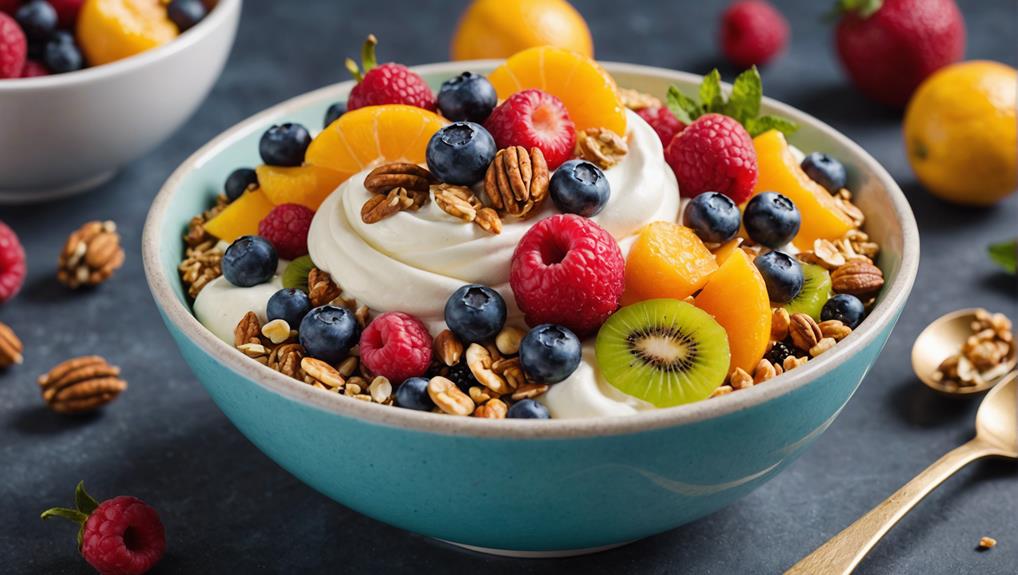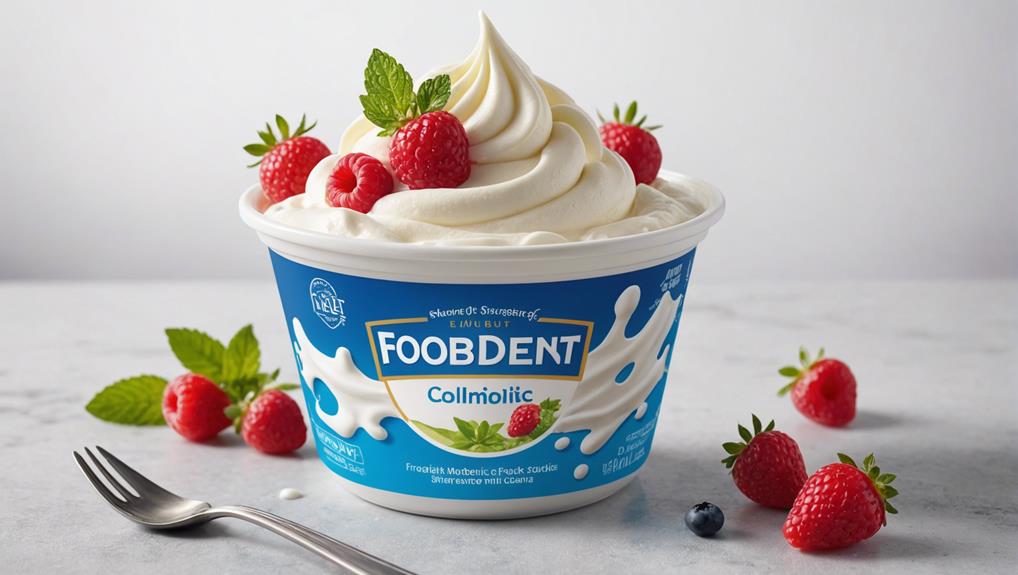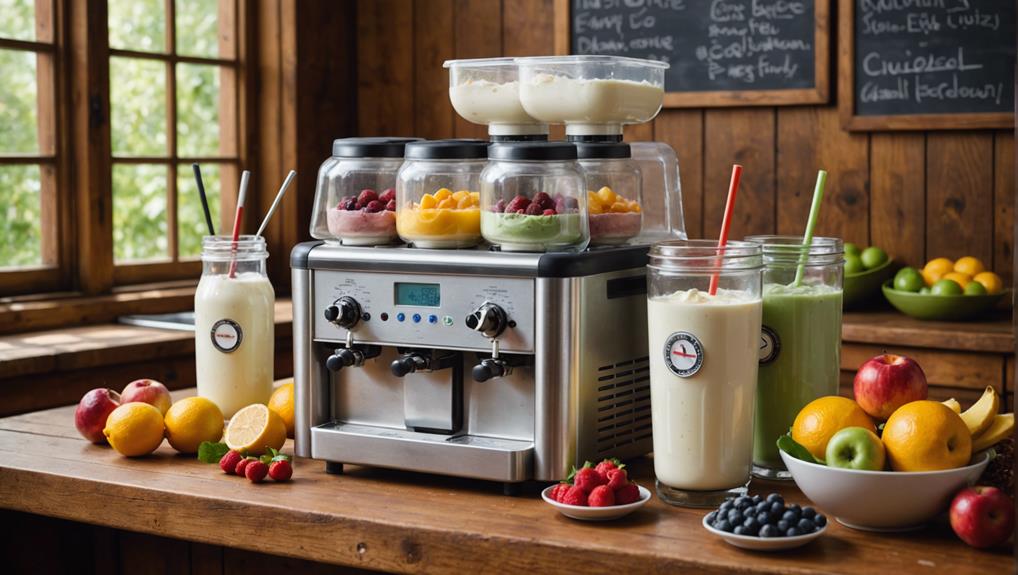Probiotics in frozen yogurt contribute significantly to gastrointestinal health and immune system support by maintaining a balanced gut microbiome. Strains like Lactobacillus and Bifidobacterium aid in digestion and modulate immune responses. Although freezing can affect probiotic viability, the dairy matrix acts as a cryoprotectant, helping preserve live cultures. Factors such as strain selection, yogurt composition, and the Live and Active Cultures seal guarantee the presence of beneficial bacteria. Milk's nutrient-rich properties enhance probiotic survival during freezing, making frozen yogurt a functional food option. Understanding these mechanisms provides deeper insights into maximizing health benefits from probiotic-rich frozen yogurt.
Key Takeaways
- Probiotics in frozen yogurt support gastrointestinal health and boost the immune system.
- The Live and Active Cultures seal ensures the presence of beneficial bacteria in frozen yogurt.
- Milk components in frozen yogurt act as cryoprotectants, enhancing probiotic viability during freezing.
- Fermentation and controlled processing optimize probiotic survival in frozen yogurt.
- Fresh yogurt generally contains more live probiotics compared to frozen yogurt.
Benefits of Probiotics

Numerous studies have demonstrated that probiotics present in frozen yogurt can greatly contribute to gastrointestinal health and immune system enhancement. The primary mechanism involves live cultures, which are beneficial bacteria that colonize the gut. These live cultures help maintain a balanced microbial environment, essential for effective digestive processes and nutrient absorption.
Probiotic bacteria, such as Lactobacillus and Bifidobacterium strains, play an essential role in modulating the immune system. They enhance the gut barrier function, preventing pathogenic organisms from causing infections and reducing systemic inflammation. This immunomodulatory effect is particularly significant for individuals with weakened immune systems or gastrointestinal disorders.
Additionally, the consumption of frozen yogurt containing live and active cultures has been linked to lowered blood pressure, attributed to the bioactive compounds produced by probiotic bacteria. This cardiovascular benefit adds another layer to the overall health advantages of incorporating probiotics into the diet.
The Live and Active Cultures seal on frozen yogurt products serves as an indicator of the presence of these beneficial bacteria, ensuring consumers receive the potential health benefits. Hence, regular intake of frozen yogurt fortified with probiotics can be an essential approach to enhancing both gut health and immune system function.
Probiotics in Dairy Products
Building on the benefits of probiotics in frozen yogurt, dairy products as a whole serve as an excellent medium for delivering these beneficial bacteria to the human gastrointestinal system. The intrinsic properties of dairy products, such as yogurt, kefir, and cheese, facilitate the growth and sustenance of probiotics like Lactobacillus and Bifidobacterium. The fermentation process involved in creating these dairy products is vital for the development of live and active cultures, which are instrumental in promoting gut health.
The fermentation process not only enhances the nutritional profile of dairy products but also creates an environment conducive to the proliferation of probiotics. Live and active cultures in these products can aid in the digestion of lactose, making them suitable for individuals with lactose intolerance. Furthermore, these probiotics play a pivotal role in maintaining a balanced gut microbiome by inhibiting pathogenic bacteria and supporting the growth of beneficial microorganisms.
Scientific evidence suggests that regular consumption of dairy products containing probiotics can strengthen the immune system and improve overall health. The presence of these live and active cultures can contribute to enhanced digestive health, reduced gastrointestinal discomfort, and potentially lower the risk of certain infections, thereby highlighting the significance of incorporating probiotic-rich dairy products into the diet.
Freezing and Probiotic Viability

The process of freezing yogurt can have a notable impact on the viability of probiotic bacteria, as different strains exhibit varying levels of resistance to low temperatures. Research indicates that the survival rate of probiotics during frozen storage is dependent on both the specific strain and the composition of the yogurt, particularly the presence of milk solids. As a result, consumers aiming to maximize health benefits should consider selecting frozen yogurts with robust probiotic strains known for their enhanced survival in frozen conditions.
Temperature Impact on Probiotics
Freezing yogurt poses a significant challenge to probiotic viability, as the temperature sensitivity of different bacterial strains varies widely. The freezing process integral to producing frozen yogurt can detrimentally affect the survival rates of probiotics. Probiotics, known for their health benefits, including digestive support, are sensitive to low temperatures, which can disrupt cellular integrity and metabolic activity.
Studies indicate that the presence of milk in frozen yogurt plays an important role in maintaining the health of these bacteria during freezing. Milk components act as cryoprotectants, which help shield probiotics from the harsh conditions of freezing. However, despite these protective measures, not all beneficial bacteria survive the process. The viability of probiotics post-freezing is strain-dependent, with some being more robust than others under sub-zero conditions.
Consumers seeking the digestive benefits of probiotic-enriched frozen yogurt should be aware that the freezing process may not preserve all the viable bacteria. This variance in survival rates can influence the overall efficacy of frozen yogurt as a probiotic source. Understanding the temperature impact on probiotics can guide more informed choices regarding the selection and consumption of probiotic-enriched frozen yogurt products.
Survival During Storage
During storage, the viability of probiotics in frozen yogurt is greatly influenced by the specific strains used and the protective effect of milk components. Freezing temperatures can have a substantial impact on the survival of probiotic bacteria, with varying sensitivities observed among different strains. For instance, some strains may exhibit higher resilience, maintaining their viability better than others when exposed to freezing conditions.
The presence of milk in frozen yogurt plays an important role in maintaining probiotic viability during storage. Milk components, such as proteins and fats, act as protective agents, buffering the probiotics against the harsh effects of freezing. However, it is important to note that not all frozen yogurt products may deliver the full probiotic benefits as advertised. This discrepancy can be attributed to the varied survival rates of probiotic strains under frozen storage conditions.
Informed consumer choices are essential for selecting frozen yogurt products that offer excellent probiotic viability. Understanding the specific strains used and their respective survival rates can guide consumers in making health-focused decisions. Consequently, the selection of appropriate probiotic strains and the protective role of milk components are paramount in ensuring the health benefits of probiotics in frozen yogurt are preserved during storage.
Strain Sensitivities to Temperature
Probiotic strains exhibit varying degrees of sensitivity to temperature, influencing their viability in frozen yogurt products. Temperature sensitivity is a critical factor determining whether these beneficial bacteria can endure the freezing process and subsequent storage conditions. Certain probiotic strains, such as Lactobacillus and Bifidobacterium species, have shown resilience to freezing, maintaining viability in frozen yogurt. Conversely, other strains may experience significant reductions in their populations due to cold-induced stress.
The viability of probiotics in frozen yogurt is largely contingent upon the specific bacterial strains utilized. For instance, Lactobacillus acidophilus and Bifidobacterium lactis are more likely to survive freezing temperatures, whereas other strains may not fare as well. This differential survival rate underscores the necessity of selecting robust strains to preserve the health benefits of frozen yogurt.
Storage temperature and duration further influence probiotic survival. Prolonged exposure to suboptimal temperatures can exacerbate the decline in viable cell counts. Consequently, understanding and addressing temperature sensitivity is paramount for optimizing the probiotic benefits in frozen yogurt. This knowledge aids in the formulation of products that best support the survival of beneficial microorganisms, ultimately enhancing their health-promoting properties.
Milk's Role in Probiotic Survival

Milk provides a nutrient-rich environment essential for enhancing probiotic viability in frozen yogurt. The fermentation process, driven by milk's biochemical properties, greatly impacts the survival rates of probiotics during freezing. Understanding these interactions is important for selecting frozen yogurt that retains maximum probiotic benefits.
Nutrient-Rich Environment
The nutrient-rich composition of milk greatly enhances the viability and functionality of probiotics in frozen yogurt, ensuring their survival during the freezing process. Milk products provide essential nutrients like lactose, proteins, and vitamins, which serve as substrates and protective agents for probiotic cultures such as Lactobacillus and Bifidobacterium. These elements are essential for maintaining the metabolic activity and cellular integrity of probiotics, enabling them to survive the flash-freezing and storage conditions typical of frozen yogurt production.
The symbiotic relationship between milk components and probiotic cultures creates an ideal environment for sustaining the health benefits associated with probiotics. Milk's inherent bioactive compounds, such as immunoglobulins and peptides, further support the growth and activity of these beneficial microorganisms.
| Nutrient | Function |
|---|---|
| Lactose | Energy source |
| Proteins | Structural support |
| Vitamins | Metabolic activity |
The presence of these nutrients in milk not only supports the survival of probiotics during freezing but also enhances their efficacy when consumed. The combination of milk and probiotics in frozen yogurt provides a dual benefit for gut health, making it a superior choice for consumers seeking functional foods that contribute to overall well-being.
Enhancing Probiotic Viability
Often overlooked, the intricate role of milk in enhancing probiotic viability within frozen yogurt is pivotal to preserving the health benefits of these microorganisms. Milk serves as a protective medium for lactic acid bacteria, buffering them against the stressors of freezing temperatures that can otherwise diminish their viability. The nutritional components in milk, such as proteins and fats, encapsulate probiotic cells, providing a stabilizing matrix that mitigates the adverse effects of freezing.
Research indicates that different strains of probiotic bacteria exhibit varying temperature sensitivities, which influence their survival rates in frozen yogurt. By selecting specific strains of lactic acid bacteria that are more resilient to cold temperatures, manufacturers can optimize probiotic viability. Additionally, the milk's intrinsic properties, including its pH and nutrient density, create a conducive environment that supports the longevity of these beneficial bacteria.
Despite the inherent challenges posed by the freezing process, informed consumer choices—such as opting for yogurt products specifically enriched with robust probiotic strains—can enhance the potential health benefits. Therefore, understanding the critical function of milk in maintaining probiotic viability is essential for both producers and consumers aiming to maximize the therapeutic efficacy of frozen yogurt.
Fermentation Process Impact
Fermentation's impact on probiotic survival in frozen yogurt is greatly influenced by the specific bacterial strains and the biochemical properties of the milk substrate. The process involves probiotic cultures such as Bifidobacterium spp. and Lactobacillus acidophilus, which are sensitive to both the fermentation and subsequent freezing stages. The intrinsic properties of milk, including its pH and nutrient content, are pivotal in maintaining probiotic viability throughout these stages.
| Bacterial Strain | Role in Fermentation | Temperature Sensitivity |
|---|---|---|
| Bifidobacterium spp. | Enhances gut health | Moderate |
| Lactobacillus acidophilus | Aids digestion | High |
| Streptococcus thermophilus | Yogurt texture | Low |
| Lactobacillus delbrueckii subsp. bulgaricus | Flavor development | Moderate |
Given these varied sensitivities, the fermentation process must be meticulously controlled to optimize the survival rates of these probiotic cultures. Milk's biochemical properties, especially its buffering capacity, play an important role in protecting these bacteria from pH fluctuations and thermal stress during fermentation and freezing. Consequently, the choice of milk substrate can have a significant impact on probiotic viability, thereby influencing the health benefits of the final frozen yogurt product. By understanding these interactions, manufacturers can better design fermentation protocols to enhance the efficacy of probiotic cultures in frozen yogurt.
Choosing Probiotic Frozen Yogurt
Selecting probiotic frozen yogurt requires careful evaluation of factors such as the presence of the Live & Active Culture seal, ingredient quality, and production techniques. The Live & Active Culture seal is a key indicator that the product contains beneficial live probiotic cultures, such as Lactobacillus bulgaricus and Streptococcus thermophilis, which are essential for the probiotic benefits associated with frozen yogurt.
The ingredient quality in probiotic frozen yogurt greatly influences its health benefits. High-quality ingredients, particularly those free from artificial additives and excessive sugars, guarantee a product that supports gut health. Additionally, the production of frozen yogurt, including the fermentation process and subsequent freezing, can impact the viability of these live cultures. It is essential to confirm that the freezing process used in production does not compromise the potency of the probiotics.
Furthermore, combining frozen yogurt with unsweetened fruits can enhance both the probiotic and overall nutritional benefits. This combination not only provides an additional source of fiber but also supports the growth and activity of beneficial bacteria within the gastrointestinal tract. Therefore, a meticulous approach to selecting probiotic frozen yogurt can optimize its health-promoting properties.
Comparing Fresh and Frozen Yogurt

Comparing fresh and frozen yogurt reveals significant differences in probiotic viability, with fresh yogurt generally containing higher levels of live cultures due to the absence of a freezing process that can diminish probiotic potency. Fresh yogurt maintains a conducive environment for probiotics, guaranteeing their survival and functionality. In contrast, the freezing process involved in producing frozen yogurt can lead to a reduction in the number of live probiotics, thereby potentially diminishing its health benefits.
Despite this, some frozen yogurt manufacturers counteract the loss of probiotics by introducing additional live cultures post-freezing. This practice aims to enhance the probiotic content, although it may not entirely match the levels found in fresh yogurt. For consumers prioritizing probiotic intake, fresh yogurt remains the superior option, given its higher and more consistent live culture content.
When selecting frozen yogurt for its probiotic benefits, it is imperative to scrutinize product labels and packaging for specific information regarding probiotic strains and quantities. This guarantees informed choices and maximizes potential health benefits. Overall, while both forms can contribute to a balanced diet, fresh yogurt offers a more reliable source of probiotics compared to its frozen counterpart.
Frequently Asked Questions
Do Probiotics Survive in Frozen Yogurt?
Probiotic strains can survive the freezing process in frozen yogurt, although their survival rates vary considerably depending on the specific strain and conditions. Research indicates that milk components aid in maintaining probiotic viability during freezing and storage.
What Does Probiotic Do for Yogurt?
Probiotics enhance yogurt by promoting gut health, providing digestive support, and potentially boosting the immune system. These beneficial bacteria contribute to a balanced gut flora, aiding nutrient absorption and reducing gut inflammation, thereby improving overall well-being.
What Happens to Probiotics When Frozen?
The freezing process impacts bacterial stability, with some probiotics enduring better than others. Essential storage conditions are vital to maintain viability, ensuring that health benefits are preserved despite the potential reduction in probiotic activity.
What Frozen Yogurt Has Live Active Cultures?
For brands comparison, notable frozen yogurt brands with live active cultures include Yasso and Stonyfield. Flavor variations range widely, and proper storage tips involve maintaining consistent freezing temperatures to guarantee probiotic viability and health benefits.
Conclusion
The incorporation of probiotics in frozen yogurt offers significant health benefits, yet the viability of these microorganisms can be compromised by freezing temperatures. Different probiotic strains exhibit varying sensitivities to cold, and milk's composition plays an important role in their survival. How can consumers make sure they are choosing probiotic-rich frozen yogurt? By understanding these factors and comparing fresh and frozen options, it becomes evident that both forms have unique advantages, dependent on the strains and production methods employed.







